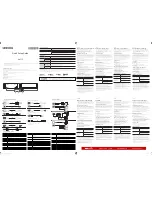
40
Rev B 2022/03
Technical Description
CyBio Well vario
4.4
Dabbing station
Observe the instructions for use (
) when using the dabbing station
(OL5021-14-600)!
4.4.1
Introduction
A pipetting cycle basically consists of aspirating the liquid into the tips, dispensing the liq-
uid, ejecting the residual liquid and returning the pistons to the starting position (zero
position). Each time the pipette tips are moved out of the liquid after residual ejection, a
film of liquid remains at the lower end of the tip, even if residual ejection was performed
with an additional volume of air.
This liquid film is aspirated back into the pipette tips when the pistons are returned to the
zero position. In principle, this residual liquid can lead to carryover. In conventional pipette
tips, this liquid film usually bursts due to the conically expanding inner diameter. The liquid
is then located on the inner wall and can be removed, for example, with a subsequent
washing cycle, thus avoiding carryover. However, a small amount of liquid will always
remain in the tips which corresponds to that in a manually pre-moistened tip. This behav-
ior is shown in figure
Fig. 28:
Typical behavior of the residual liquid in normal pipette tips
when resetting the pistons to the zero position
1 Tip in liquid after residual ejection
2 Tip is moved out of liquid, residual liquid film remains
3 Piston is moved to zero position; residual liquid is aspirated into pipette tip
4 Liquid film bursts, residual liquid can be removed with subsequent washing cycle
This behavior changes in the case of very small tips
≤
10
μ
l made of polypropylene and
capillaries made of glass, steel or ceramic. As the inner diameter does not expand upwards,
or only very slightly, the liquid film does
not
burst when the pistons are returned to the
zero position and the residual liquid cannot be removed.
This leads to carryover and, in the worst case, can result in an accumulation of the residual
liquid in the pipetting head (
).
Summary of Contents for Analytik Jena CyBio Well vario
Page 1: ...User Manual CyBio Well vario ...
Page 3: ...Rev B 2022 03 III CyBio Well vario ...
Page 5: ...Rev B 2022 03 V CyBio Well vario ...
Page 6: ...VI Rev B 2022 03 CyBio Well vario ...
Page 7: ...Rev B 2022 03 VII CyBio Well vario ...
Page 8: ...VIII Rev B 2022 03 CyBio Well vario ...
Page 12: ...XII Rev B 2022 03 CyBio Well vario ...
Page 16: ...XVI Rev B 2022 03 CyBio Well vario ...
Page 26: ...10 Rev B 2022 03 Technical Specifications CyBio Well vario ...
Page 62: ...46 Rev B 2022 03 Technical Description CyBio Well vario ...
Page 118: ...102 Rev B 2022 03 Troubleshooting CyBio Well vario ...
Page 126: ...110 Rev B 2022 03 Decommissioning CyBio Well vario ...
Page 130: ...114 Rev B 2022 03 Accessories Spare Parts CyBio Well vario ...
Page 132: ...116 Rev B 2022 03 Waste Disposal CyBio Well vario ...
Page 142: ...126 Rev B 2022 03 CyBio Well vario ...
















































